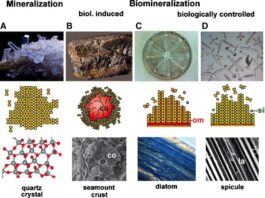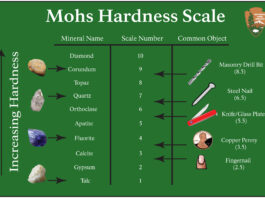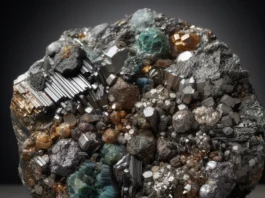Fulgurites are fascinating natural formations created when lightning strikes sand or soil, melting it into glassy tubes or branching structures. The word “fulgurite” originates from the Latin word “fulgur,” meaning lightning. These formations vary in size, shape, and composition, often resembling twisted, elongated tubes or delicate, branching structures.

Definition of Fulgurites:
Fulgurites are geological features formed when lightning strikes the ground, fusing sand or soil into glassy structures. They are essentially petrified remnants of lightning strikes, capturing the intense energy and heat generated during the event. Fulgurites can range in size from small, millimeter-scale tubes to large, meter-long formations, depending on factors such as the energy of the lightning strike, the composition of the soil or sand, and environmental conditions.
Brief History and Discovery:
Fulgurites have captured human curiosity for centuries. Although their formation was likely observed long before scientific explanations were available, their true nature wasn’t fully understood until modern geological studies emerged.
The earliest documented references to fulgurites date back to ancient times. For instance, the ancient Greeks and Egyptians revered fulgurites as mystical objects, associating them with the power of lightning and the gods. However, it wasn’t until the advent of modern geology that fulgurites were scientifically studied and understood.
In the 18th and 19th centuries, with the advancement of scientific inquiry, fulgurites gained attention from naturalists and geologists. They were recognized as unique geological formations resulting from lightning strikes. Since then, scientists have conducted extensive research to understand the formation processes, structure, and significance of fulgurites in various geological contexts.
Importance of Studying Fulgurites:
Studying fulgurites offers valuable insights into the processes and effects of lightning strikes on the Earth’s surface. Some key reasons why fulgurites are important to study include:
- Understanding Lightning Phenomena: Fulgurites provide tangible evidence of lightning strikes, aiding in the understanding of lightning behavior, energy distribution, and impact on geological materials.
- Geological Significance: Fulgurites serve as natural archives of past lightning activity, contributing to the study of geological processes and landscape evolution. They also offer clues about the composition and characteristics of the local soil or sand.
- Material Science Applications: The unique glassy structure of fulgurites makes them valuable for studying the behavior of materials subjected to extreme heat and pressure. Insights gained from fulgurite research can inform various fields, including materials science, geophysics, and planetary science.
- Environmental Indicators: Fulgurites can provide information about past environmental conditions and climatic patterns, as their formation is influenced by factors such as soil composition, moisture content, and atmospheric conditions.
In conclusion, fulgurites represent captivating geological formations with significant scientific value. By studying fulgurites, researchers can gain insights into lightning phenomena, geological processes, and material behavior under extreme conditions, with potential applications across multiple disciplines.
Contents
Formation of Fulgurites

Fulgurites form through a fascinating process that involves the intense heat and energy generated by a lightning strike interacting with the surrounding soil or sand. The formation process can be broken down into several key steps:
- Lightning Strike: Fulgurites begin to form when a lightning bolt strikes the ground. Lightning is an electrical discharge caused by the buildup of static electricity within clouds, between clouds, or between a cloud and the ground. When lightning strikes the Earth’s surface, it delivers an immense amount of energy in a fraction of a second.
- Melting of Material: The intense heat produced by the lightning bolt, which can reach temperatures exceeding 30,000 degrees Celsius (54,000 degrees Fahrenheit), instantaneously vaporizes and melts the surrounding soil or sand. This rapid heating causes the material to undergo significant changes, including melting and fusion.
- Glass Formation: As the material melts, it fuses together and cools rapidly, forming glassy structures. The glass that forms from the melted material of fulgurites is primarily composed of silica (SiO2), which is abundant in most sands and soils. The specific composition and characteristics of the resulting glass depend on factors such as the composition of the soil or sand, the energy of the lightning strike, and environmental conditions.
- Tube Formation: Fulgurites often take the form of hollow, tubular structures. This tube-like morphology is a result of the vaporized material being ejected outward from the lightning channel as the lightning strike progresses through the ground. The vaporized material cools and solidifies along the path of the lightning channel, forming a hollow tube or cavity. The size and shape of fulgurite tubes can vary widely, ranging from small, thin tubes to larger, more complex structures.
- Cooling and Solidification: Once the lightning strike dissipates and the heat from the strike diminishes, the molten material cools and solidifies, preserving the glassy structure of the fulgurite. The cooling process can occur rapidly due to the high conductivity of sand or soil, resulting in the formation of a stable fulgurite structure.
Overall, fulgurites form through the rapid melting, fusion, and solidification of sand or soil in response to the extreme heat and energy of a lightning strike. This unique formation process results in the creation of intricate glassy structures that serve as tangible records of the immense power of lightning.
Characteristics of Fulgurites

Fulgurites exhibit several distinctive characteristics that make them unique geological formations. Some of the key characteristics of fulgurites include:
- Glassy Composition: Fulgurites are primarily composed of glass, formed from the rapid melting and solidification of sand or soil during a lightning strike. This glassy material often has a translucent or transparent appearance, with varying degrees of clarity depending on factors such as the composition of the original substrate and the conditions of formation.
- Tubular or Branching Structures: Fulgurites typically exhibit tubular or branching structures, resulting from the path taken by the lightning strike through the ground. The formation of these structures involves the vaporization and ejection of material along the lightning channel, which cools and solidifies to form hollow tubes or branching patterns within the fulgurite.
- Variable Sizes: Fulgurites can vary widely in size, ranging from small, millimeter-scale tubes to larger, meter-long formations. The size of fulgurites is influenced by factors such as the energy of the lightning strike, the composition of the substrate, and environmental conditions.
- Distinctive Surface Features: Fulgurites often exhibit distinctive surface features, such as smooth or rippled textures, caused by the flow and solidification of molten material during formation. These surface features can provide insights into the dynamics of the lightning strike and the conditions under which the fulgurite formed.
- Presence of Inclusions: Fulgurites may contain various inclusions, including mineral grains, organic matter, and metallic particles, captured during the formation process. These inclusions can provide valuable information about the composition of the substrate and the environmental conditions at the time of formation.
- Conductivity: Due to their glassy composition, fulgurites exhibit high electrical conductivity, which can be several orders of magnitude higher than that of the surrounding soil or sand. This conductivity is a result of the presence of metallic ions and the interconnected network of glassy material within the fulgurite.
- Fragility: Despite their glassy appearance, fulgurites are often relatively fragile and can be easily broken or fragmented. Care must be taken when handling fulgurites to avoid damage to their delicate structures.
Overall, the characteristics of fulgurites reflect their unique formation process and provide valuable insights into the dynamics of lightning strikes and their effects on geological materials. Studying fulgurites can contribute to our understanding of lightning phenomena, geological processes, and environmental conditions.
Types of Fulgurites

Fulgurites can be categorized into several types based on various factors such as their morphology, composition, and formation process. Some of the commonly recognized types of fulgurites include:
- Sand Fulgurites: Sand fulgurites are formed when lightning strikes sandy soil or beaches. These fulgurites typically have a glassy composition and exhibit tubular or branching structures. Sand fulgurites are among the most common types of fulgurites due to the abundance of sandy substrates.
- Soil Fulgurites: Soil fulgurites are formed when lightning strikes soil rich in clay or organic matter. Unlike sand fulgurites, soil fulgurites may contain higher concentrations of organic material and mineral inclusions, resulting in variations in composition and color. Soil fulgurites often exhibit more irregular or dendritic branching patterns compared to sand fulgurites.
- Rock Fulgurites: Rock fulgurites, also known as petrified lightning or lightning-induced rocks, are formed when lightning strikes solid rock formations. The intense heat and energy of the lightning strike can cause localized melting and fusion of the rock, resulting in the formation of glassy veins or inclusions within the rock matrix.
- Composite Fulgurites: Composite fulgurites are formed when lightning strikes a mixture of different materials, such as sand, soil, rocks, or man-made objects. These fulgurites may exhibit complex compositions and structures, incorporating elements from the various materials involved in the lightning strike.
- Artifact Fulgurites: Artifact fulgurites are formed when lightning strikes man-made objects, such as metal poles, wires, or structures, embedded in soil or sand. The intense heat generated by the lightning strike can melt and fuse the surrounding material with the object, forming distinctive fulgurite-like features.
- Pseudofulgurites: Pseudofulgurites are geological formations that resemble fulgurites but are not formed by lightning strikes. These formations may result from other natural processes, such as volcanic activity, or human activities, such as welding or industrial processes. Pseudofulgurites can sometimes be distinguished from true fulgurites based on their geological context, composition, and structural characteristics.
These are just a few examples of the types of fulgurites that can be found in nature. Each type of fulgurite exhibits unique characteristics, reflecting the specific conditions under which it formed. Studying the different types of fulgurites can provide valuable insights into lightning phenomena, geological processes, and the interactions between lightning and geological materials.
Locations and Distribution

Fulgurite: What is Fulgurite and Types of Fulgurite | Geology In
Fulgurites can be found in various natural environments around the world, with their formation primarily influenced by the presence of lightning-prone areas, as well as the composition and characteristics of the substrate. Some of the natural environments where fulgurites are commonly found include:
- Deserts: Desert environments, characterized by extensive sandy or rocky landscapes, are ideal locations for the formation of fulgurites. Regions such as the Sahara Desert in Africa, the Mojave Desert in North America, and the Australian Outback are known for their abundance of sand and frequent lightning activity, making them prime locations for the formation of sand fulgurites.
- Beaches: Coastal areas with sandy beaches are also common locations for the formation of sand fulgurites. Lightning strikes along sandy shorelines can result in the formation of fulgurites buried beneath the surface or exposed along the beach after erosion processes. Beaches in regions with high lightning activity, such as Florida in the United States or tropical regions worldwide, may have a higher prevalence of fulgurites.
- Grasslands and Savannas: Grasslands and savannas, characterized by a mixture of grasses, shrubs, and soil, can also host fulgurites. Lightning strikes in these environments can result in the formation of soil fulgurites, where the lightning channels follow paths through the soil rich in organic matter and mineral content.
- Mountainous Regions: Mountainous regions with rocky terrain and exposed bedrock can be sites of rock fulgurite formation. Lightning strikes on exposed rock formations can cause localized melting and fusion of the rock, leading to the formation of glassy veins or inclusions within the rock matrix.
- Volcanic Areas: Volcanic areas with recent or ongoing volcanic activity may also host fulgurites, particularly in regions where lightning activity coincides with volcanic eruptions. Lightning strikes during volcanic eruptions can interact with volcanic ash and debris, resulting in the formation of fulgurite-like features known as pseudofulgurites.
Geographically, fulgurites can be found on every continent, although their distribution may vary depending on factors such as climate, topography, and geological characteristics. Regions with a combination of lightning activity and suitable substrates, such as sandy soils or rocky formations, are more likely to have a higher prevalence of fulgurites. As a result, fulgurites can be found in diverse locations worldwide, ranging from arid deserts to tropical rainforests and coastal regions to mountainous terrain.
Uses of Fulgurites

Fulgurites have several potential uses and applications across various fields due to their unique characteristics and formation process. Some of the notable uses of fulgurites include:
- Scientific Research: Fulgurites provide valuable insights into lightning phenomena, geological processes, and material behavior under extreme conditions. Scientists study fulgurites to better understand the dynamics of lightning strikes, the effects of lightning on geological materials, and the formation of glassy structures in nature.
- Materials Science: Fulgurites serve as natural examples of glass formation under extreme heat and pressure, making them valuable for studying material properties and behavior. Researchers in materials science and engineering use fulgurites to investigate the properties of glassy materials and their potential applications in various industries, such as aerospace, electronics, and construction.
- Geological Studies: Fulgurites are geological formations that provide insights into past lightning activity, environmental conditions, and landscape evolution. Geologists study fulgurites to reconstruct past environments, assess the frequency and intensity of lightning strikes in different regions, and interpret the geological significance of fulgurite-bearing deposits.
- Artistic and Decorative Purposes: Fulgurites’ unique appearance and glassy texture make them popular for artistic and decorative purposes. Artists and collectors use fulgurites to create jewelry, sculptures, and other artistic works, showcasing the natural beauty and intricate structures of these formations.
- Education and Outreach: Fulgurites are often used in educational settings to teach students about lightning, geology, and natural processes. Exhibits featuring fulgurite specimens can engage and inspire curiosity among learners of all ages, fostering an appreciation for the natural world and scientific inquiry.
- Historical and Cultural Significance: Fulgurites have historical and cultural significance in various societies, where they have been revered as mystical objects or symbols of power. Archaeologists and historians study fulgurites found at archaeological sites to understand their cultural significance and the beliefs associated with lightning in different cultures throughout history.
Overall, fulgurites have diverse uses and applications in scientific research, materials science, education, art, and cultural heritage, highlighting their importance as unique geological formations with both scientific and cultural value.






